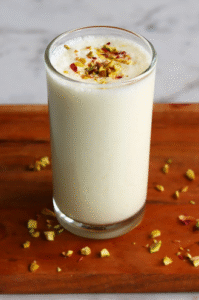Lassi is a traditional Indian beverage made by blending yogurt with water, often flavoured with spices, sweeteners, or fruits. It comes in both sweet and salty forms and is known for its smooth, creamy texture and cooling effect, making it especially popular during hot weather. Common ingredients include sugar, salt, cardamom, cumin, rose water, mango, and ice. A staple in North Indian cuisine—especially Punjab—lassi is enjoyed both as a refreshing drink and a digestive aid.

The history of lassi dates back over 1,000 years, deeply rooted in Indian culinary and Ayurvedic traditions.
Ancient Origins:
-
Ayurvedic Roots: Lassi is believed to have originated in the Punjab region of India and is mentioned in Ayurvedic texts, where it was praised for its digestive benefits and cooling properties.
-
Traditional Use: In ancient times, lassi was consumed to balance the body’s internal heat, especially during hot summers. It was often flavored with spices like cardamom, cumin, and turmeric to aid digestion.
Medieval Period:
-
During the Mughal era, lassi gained further popularity and refinement. Sweet versions became more common, sometimes enriched with rose water, saffron, and dry fruits, echoing the luxurious style of Mughal cuisine.
Global Spread:
-
With Indian migration and globalization, lassi—especially mango lassi—became widely known internationally, featured in Indian restaurants across the UK, US, Canada, and beyond.
-
It’s now seen as both a health drink and a dessert beverage, appreciated worldwide for its taste and probiotic benefits.
Cultural Significance:
-
In India, lassi is still a daily staple, especially in Punjab, where it’s often served in large steel glasses with a thick layer of cream on top.
-
It’s commonly offered to guests and consumed during festivals, harvest celebrations, and summer months.
